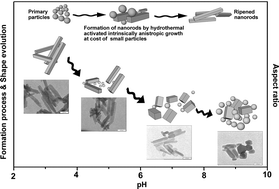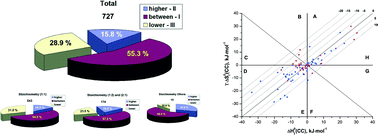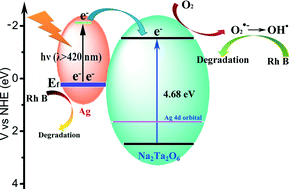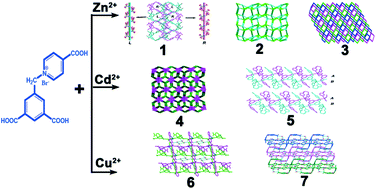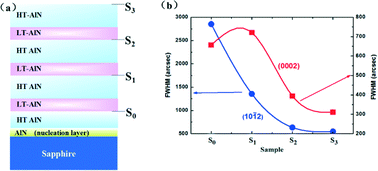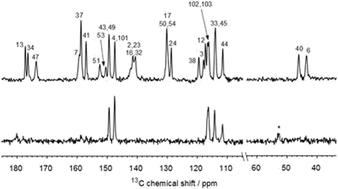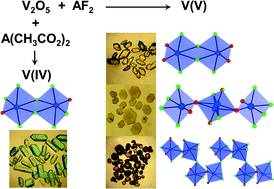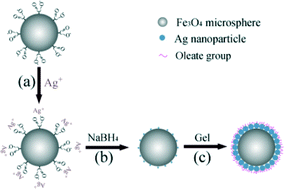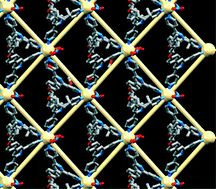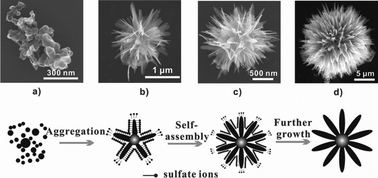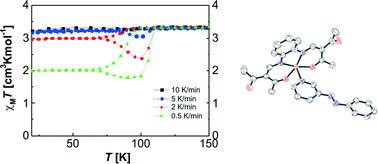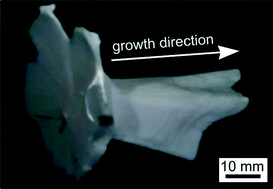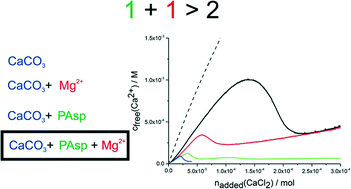| Below, you can find a selection of articles that showcase the breadth of cutting-edge research published in CrystEngComm, on the design and understanding of solid-state and crystalline materials.
We want to share these articles with you, for your reading pleasure.
|
Showcasing the breadth of research published in CrystEngComm
A red-emitting nanophosphor for white LEDs
A new red-emitting nanophosphor with potential use in white light-emitting diodes (LEDs) has recently been reported by Mi and colleagues.
White LEDs are used for lighting as they use little energy, have high brightness and long lifetimes and are considered environmentally friendly. Currently, these LEDs consist of a combination of a yellow-emitting phosphor and a blue LED chip. However, the lack of a red component is problematic, leading to a low colour rendering index (in other words, some colours do not appear naturalistic) and a high colour temperature (giving light a blue hue). Other possible methods of generating white LEDs that use red phosphors are limited by the low stability and efficiency of commercial sulphide-based red phosphors. Now, Mi and colleagues report an efficient and stable europium-based red phosphor that could solve the problem and improve the suitability of white LEDs for certain medical applications.
The phosphor Ca9Eu(PO4)7 was prepared using hydrothermal methods from calcium- and europium- nitrates and phosphoric acid. It shows a red emission at 616nm under excitation at 397nm. This is attributed to the 5D0 →7F2 transition in Eu3+, which will only happen when the Eu ion occurs in sites without inversion symmetry (as it is parity forbidden).
When the phosphor was doped (in other words, when Eu was partially replaced by Gd, La or Y), the emission intensity decreased. The pH value of the synthesis reaction was found to alter the morphology of the phosphor (see the diagram below) from rods to spheres, which had different luminescence properties. The most favourable properties were obtained from rods obtained at pH 7, attributed to the smallest number of lattice defects being formed at this pH. The rods are approximately 100nm long with an aspect ratio (long axis length to width ratio) of 2.5. This phosphor shows a good colour saturation index (R = 2.4) and future studies to optimise its properties could lead to potential application in white LEDs.
For more details read the full paper at:
Hydrothermal synthesis and photoluminescence properties of Ca9Eu(PO4)7 nanophosphors
Jiacheng Sun, Xiaoyun Mi, Lijian Lei, Xiaoying Pan, Shuyi Chen, Zan Wang, Zhaohui Bai and Xiyan Zhang
CrystEngComm, 2015
DOI: 10.1039/C5CE01289A
__________________________________________________________________________________________________
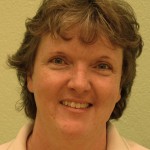 Gwenda Kyd has a PhD in metallocarborane chemistry from the University of Edinburgh. Other research work includes the spectroscopic study of the structure of glasses and organometallic electron-transfer reactions and the preparation of new inorganic phosphors. She has recently published a book on chemicals from plants.
Gwenda Kyd has a PhD in metallocarborane chemistry from the University of Edinburgh. Other research work includes the spectroscopic study of the structure of glasses and organometallic electron-transfer reactions and the preparation of new inorganic phosphors. She has recently published a book on chemicals from plants.
October’s HOT articles
October brings a new selection of HOT articles below. These are free to access for 4 weeks and have been compiled into a collection available for viewing on our website.
Lipid or aqueous medium for hematin crystallization?
Peter G. Vekilov, Jeffrey D. Rimer, Katy N. Olafson and Megan A. Ketchum
CrystEngComm, 2015, Advance Article
DOI: 10.1039/C5CE01178G
Free to access until 5th November 2015
Versatile solid modifications of icariin: structure, properties and form transformation
Lina Jia, Qi Zhang, Jian-Rong Wang and Xuefeng Mei
CrystEngComm, 2015, 17, 7500-7509
DOI: 10.1039/C5CE01422K
Free to access until 5th November 2015
Professor Rahul Banerjee Wins Thomson Reuters Research Excellence – India Citation Award 2015
We are delighted to announce that Professor Rahul Banerjee (Associate Editor, CrystEngComm) was recently selected as one of the winners of the Thomson Reuters Research Excellence – India Citation Awards 2015.
Through research citations within Web of ScienceTM, the Awards identify and recognize India’s most prominent scientists and researchers for their outstanding and pioneering research and influential contribution to global R&D.
Congratulations, Professor Banerjee!
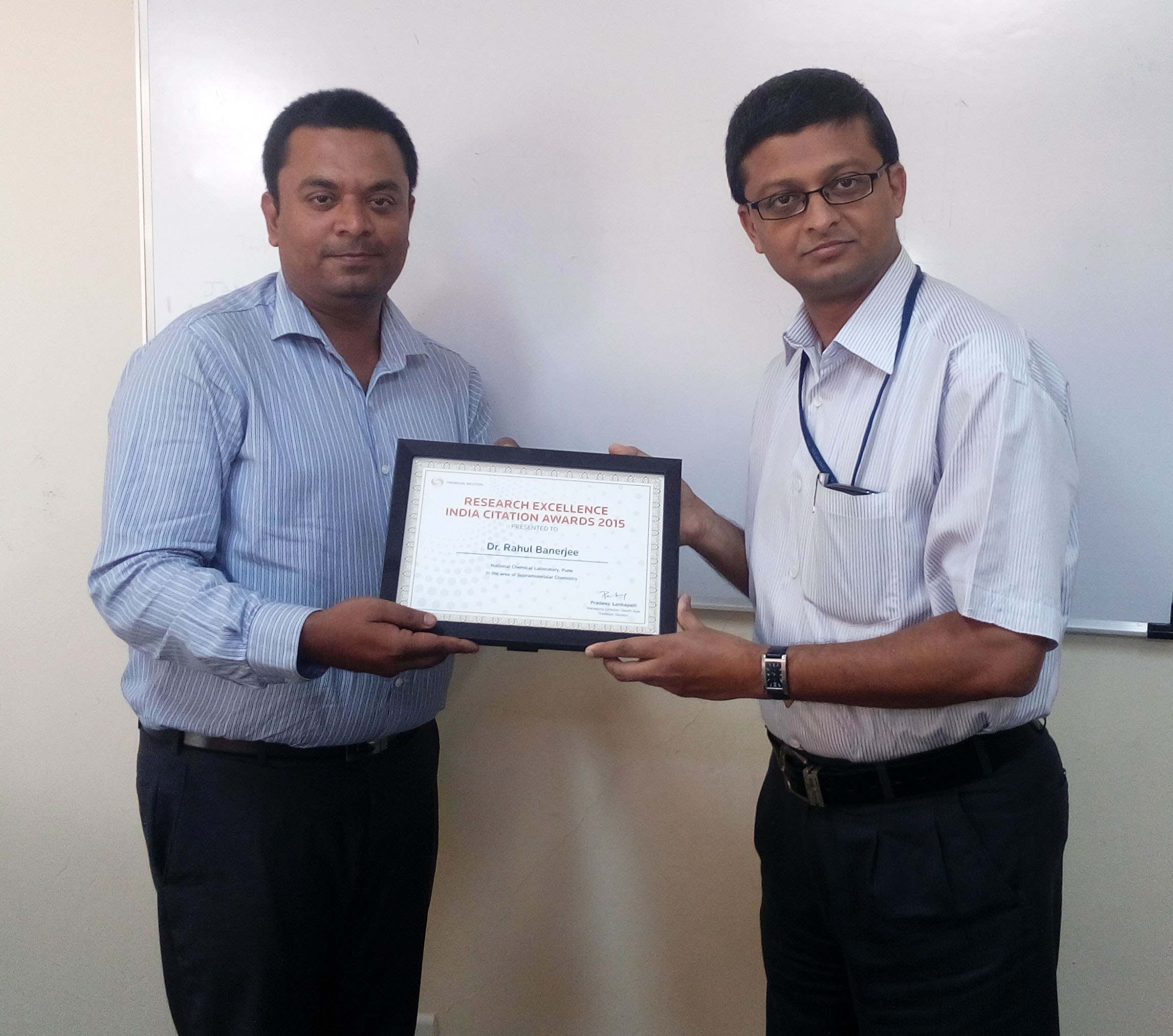
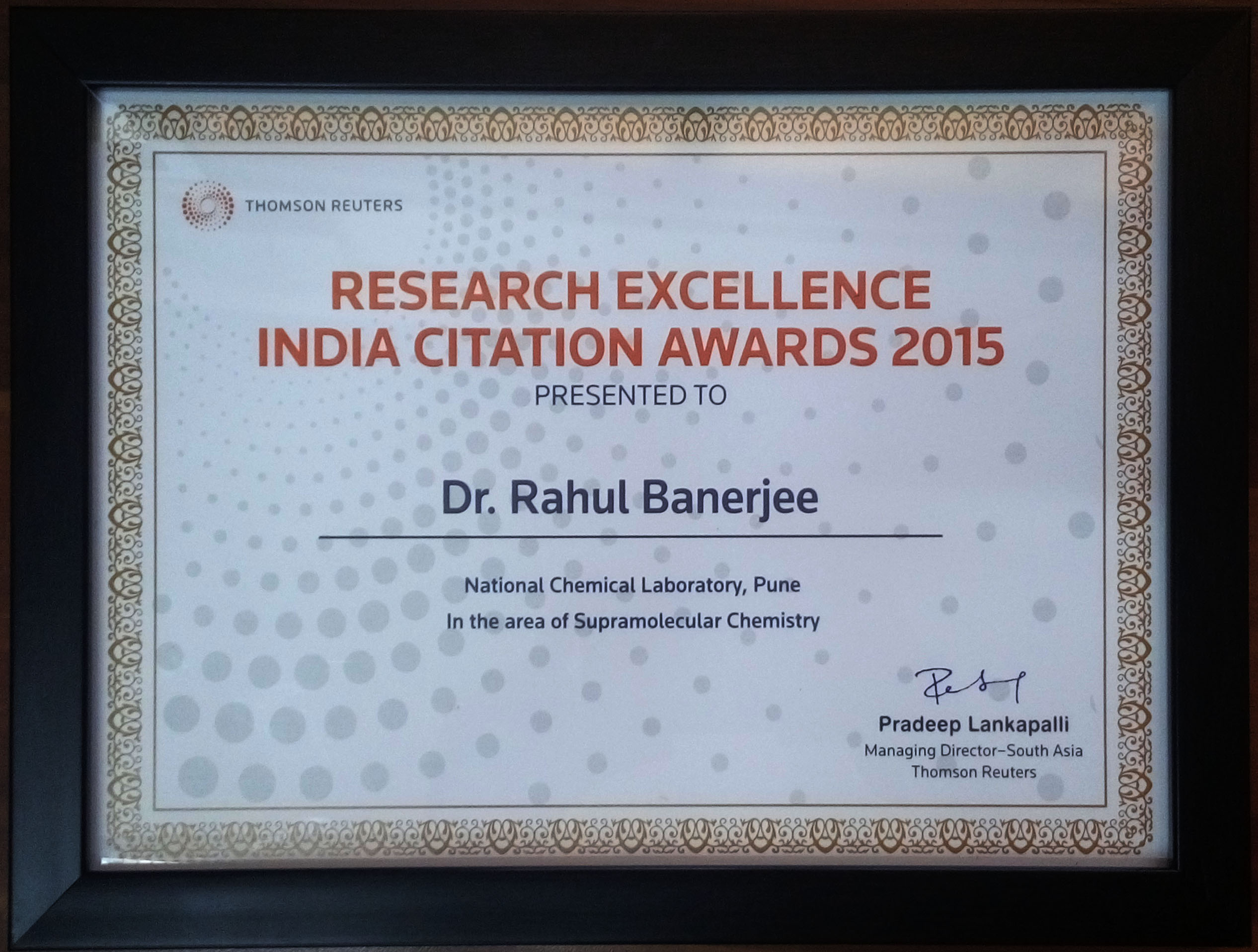
__Professor Banerjee (right) receives his Thomson
__Reuters Research Excellence – India Citation Award
September’s HOT articles
Our September selection of HOT articles are below. These are only free to access for 4 weeks. The articles have also been compiled into a collection available for viewing on our website.
Thermodynamic characteristics of cocrystal formation and melting points for rational design of pharmaceutical two-component systems
German L. Perlovich
CrystEngComm, 2015, 17, 7019-7028
DOI: 10.1039/C5CE00992H
Free to access until 16th October 2015
Simultaneous doping and heterojunction of silver on Na2Ta2O6 nanoparticles for visible light driven photocatalysis: the relationship between tunable optical absorption, defect chemistry and photocatalytic activity
Tingting Wang, Junyu Lang, Yingjie Zhao, Yiguo Su, Yanxia Zhao and Xiaojing Wang
CrystEngComm, 2015, 17, 6651-6660
DOI: 10.1039/C5CE01125F
Free to access until 16th October 2015
Transformation of rigid metal-organic frameworks into flexible gel networks and vice versa
José Juan Marrero-Tellado and David Diaz
CrystEngComm, 2015, Accepted Manuscript
DOI: 10.1039/C5CE01032B
Free to access until 16th October 2015
Construction of a series of metal–organic frameworks based on novel flexible ligand 4-carboxy-1-(3,5-dicarboxy-benzyl)-pyridinium chloride and selective d-block metal ions: crystal structures and photoluminescence
Hai-Yang Li, Li-Hui Cao, Yong-Li Wei, Hong Xu and Shuang-Quan Zang
CrystEngComm, 2015, 17, 6297-6307
DOI: 10.1039/C5CE01008J
Free to access until 16th October 2015
Epitaxial growth of AlN films on sapphire via a multilayer structure adopting a low- and high-temperature alternation technique
X. Zhang, F. J. Xu, J. M. Wang, C. G. He, L. S. Zhang, J. Huang, J. P. Cheng, Z. X. Qin, X. L. Yang, N. Tang, X. Q. Wang and B. Shen
CrystEngComm, 2015, Advance Article
DOI: 10.1039/C5CE01159K
Free to access until 16th October 2015
A furosemide–isonicotinamide cocrystal: an investigation of properties and extensive structural disorder
Hannah E. Kerr, Lorna K. Softley, Kuthuru Suresh, Ashwini Nangia, Paul Hodgkinson and Ivana Radosavljevic Evans
CrystEngComm, 2015, 17, 6707-6715
DOI: 10.1039/C5CE01183C
Free to access until 16th October 2015
Synthetic strategies for new vanadium oxyfluorides containing novel building blocks: structures of V(IV) and V(V) containing Sr4V3O5F13, Pb7V4O8F18, Pb2VO2F5, and Pb2VOF6
Jeongho Yeon, Justin B. Felder, Mark D. Smith, Gregory Morrison and Hans-Conrad zur Loye
CrystEngComm, 2015, Advance Article
DOI: 10.1039/C5CE01464F
Free to access until 16th October 2015
New probes for detecting the pesticide thiram by SERS
Highly selective and sensitive surface enhanced Raman spectroscopy (SERS) probes for the pesticide thiram have recently been reported by Zou and Wang et al.
SERS can provide low-cost, non-destructive, fast detection of potential environmental pollutants such as thiram. This sulfur-containing pesticide and fungicide is commonly used to protect orchard fruits and soya but is toxic to humans both in acute doses and by long-term exposure to smaller quantities.
An effective SERS substrate has a rough metal surface – typically made of noble metals such as Ag – which adsorbs the molecules of interest. The surface is coated on a glass or a core metal oxide particle, such as Fe3O4. After oleate-modified Ag microspheres were found to possess selective thiram detection by surface-ligand exchange, attempts were made to generate Ag composite microspheres with oleate modifications, using a gel system. However, the dumb-bell shaped particles produced showed a poor SERS performance, due to the lack of so-called hot-spots – areas where surface enhancement is intense.
In the new paper, the successful preparation of oleate-modified silver composite microspheres with dense hot-spots is demonstrated. The Fe3O4 microspheres, capped with polyacrylate groups are prepared by a solvothermal method. The carboxylate groups interact with Ag ions which are subsequently reduced using sodium borohydrate. The surface Ag particles seed further coating by Ag in the presence of oleate in a gel system (see diagram below), completely covering the Fe3O4 microsphere in oleate-modified Ag nanoparticles.
The spherical particles produced show SERS detection of thiram at trace amounts, with the thiram spectrum detected at a concentration as low as 1 x 10−8 M. Under the same conditions, two other common pesticides, methyl parathion and trichorfon, show no SERS signals. The results suggest that the system could potentially be used for the selective detection of traces of thiram in solution.
For more details, see the full paper at:
Gel-assisted synthesis of oleate-modified Fe3O4@Ag composite microspheres as magnetic SERS probe for thiram detection
Haihong Zheng, Bingfang Zou, Lin Chen, Yongqiang Wang, Xiaoli Zhang and Shaomin Zhou
CrystEngComm, 2015, Advance Article
DOI: 10.1039/C5CE01017A
__________________________________________________________________________________________________
 Gwenda Kyd has a PhD in metallocarborane chemistry from the University of Edinburgh. Other research work includes the spectroscopic study of the structure of glasses and organometallic electron-transfer reactions and the preparation of new inorganic phosphors. She has recently published a book on chemicals from plants.
Gwenda Kyd has a PhD in metallocarborane chemistry from the University of Edinburgh. Other research work includes the spectroscopic study of the structure of glasses and organometallic electron-transfer reactions and the preparation of new inorganic phosphors. She has recently published a book on chemicals from plants.
August’s HOT articles
August’s HOT articles are below. Remember that these are only free to access for 4 weeks. The articles have been compiled into a collection and are available for viewing on our website.
Manipulating connecting nodes through remote alkoxy chain variation in coordination networks with 4′-alkoxy-4,2′:6′,4”-terpyridine linkers
Y. Maximilian Klein, Alessandro Prescimone, Edwin C. Constable and Catherine E. Housecroft
CrystEngComm, 2015, Advance Article
DOI: 10.1039/C5CE01115A
Free to access until 26th August 2015
Polyoxometalate-directed assembly and various structures of inorganic–organic hybrid compounds based on a semi-rigid bis-pyridyl-bis-amide
Xiu-Li Wang, Na Xu, Xun-Zhang Zhao, Ju-Wen Zhang, Chun-Hua Gong and Tian-Jiao Li
CrystEngComm, 2015, Advance Article
DOI: 10.1039/C5CE00962F
Free to access until 26th August 2015
Sensing hazardous gases using tungsten trioxide microflowers
A facile new preparation of shape-controlled tungsten trioxide (WO3) sensors is reported in a recent paper by Zhang et al. These sensors show good selectivity towards the hazardous gas hydrogen sulfide (H2S) at a relatively low operating temperature.
Detection of hazardous gases is necessary to monitor environmental pollution and ensure levels do not exceed legally permitted limits. In the case of H2S, the general industry ceiling limit is 20 ppm. At concentrations of above 50 ppm, eye damage is likely and at higher concentrations (above 320 ppm) pulmonary oedema and breathing problems resulting in death can occur. There is, therefore, a demand for cheap, reliable and selective sensors for identifying low concentrations of H2S.
Metal-oxide semiconductors such as WO3 are attractive potential sensors which are relatively cheap and easy to fabricate. As the sensing ability of the particles depends on their morphology, the preparation of shape-controlled particles is a requirement. Zhang et al achieve this by reacting sodium tungstate and potassium sulfate in an acidic environment. Adding oxalic acid and heating at 100oC then calcining the resulting product produces WO3 microflowers, of diameter 16 μm. Study of the reaction shows it can be divided into four processes. Crucially, during the final stage, needle-like nanosheets grow radially from central particles to produce a flower-like morphology (see the scheme below).
These particles have excellent potential for application as H2S sensors – at 160oC they show high sensitivity and sensor response along with good repeatability and selectivity towards H2S. The high performance of WO3 microflowers is related to their structure. They are assembled from nanosheets composed of several nanowhiskers in parallel, giving highly exposed surfaces and so more pathways for gas absorption and electron exchange. The nanosheets are homogeneous and single-crystalline so electron transport can occur between particles without overcoming boundary barriers which would decrease the sensitivity.
For more details, read the full paper at:
Low-temperature solvothermal synthesis of hierarchical flower-like WO3nanostructures and their sensing properties for H2S
Bingxin Xiao, Qi Zhao, Chuanhai Xiao, Tianye Yang, Pan Wang, Fei Wang, Xiaodong Chen and Mingzhe Zhang
CrystEngComm, 2015
DOI: 10.1039/C5CE00870K
____________________________________________________________________________________________
 Gwenda Kyd has a PhD in metallocarborane chemistry from the University of Edinburgh. Other research work includes the spectroscopic study of the structure of glasses and organometallic electron-transfer reactions and the preparation of new inorganic phosphors. She has recently published a book on chemicals from plants.
Gwenda Kyd has a PhD in metallocarborane chemistry from the University of Edinburgh. Other research work includes the spectroscopic study of the structure of glasses and organometallic electron-transfer reactions and the preparation of new inorganic phosphors. She has recently published a book on chemicals from plants.
July’s HOT articles
Take a look at July’s HOT articles and remember that these are only free to access for 4 weeks. The HOT article have been compiled into a collection and are available for viewing on our website.
Growth of high quality single crystals of strontium doped (Nd,Pr)-nickelates, Nd2−xSrxNiO4+δ and Pr2−xSrxNiO4+δ
O. Wahyudi, M. Ceretti, I. Weill, A. Cousson, F. Weill, M. Meven, M. Guerre, A. Villesuzanne, J.-M. Bassat and W. Paulus
CrystEngComm, 2015, Advance Article
DOI: 10.1039/C5CE00906E
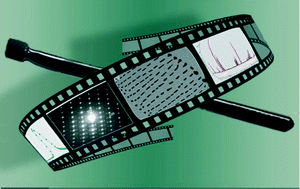
Free to access until 6th August 2015
1D iron(II) spin crossover coordination polymers with 3,3′-azopyridine – kinetic trapping effects and spin transition above room temperature
Sophie Schönfeld, Charles Lochenie, Peter Thoma and Birgit Weber
CrystEngComm, 2015, Advance Article
DOI: 10.1039/C5CE00800J
Free to access until 6th August 2015
Diamond crystallization from an Mg–C system under high pressure, high temperature conditions
Y. N. Palyanov, Y. M. Borzdov, I. N. Kupriyanov, A. F. Khokhryakov and D. V. Nechaev
CrystEngComm, 2015, 17, 4928-4936
DOI: 10.1039/C5CE00897B
Free to access until 6th August 2015
Scalable synthesis of djurleite copper sulphide (Cu1.94S) hexagonal nanoplates from a single precursor copper thiocyanate and their photothermal properties
Donghwan Yoon, Haneul Jin, Suho Ryu, Suhyun Park, Hionsuck Baik, Seung Jae Oh, Seungjoo Haam, Chulmin Joo and Kwangyeol Lee
CrystEngComm, 2015, 17, 4627-4631
DOI: 10.1039/C5CE00638D
Free to access until 6th August 2015
Macroscopic glass-permeated single-crystals of fresnoite
Wolfgang Wisniewski, Marcus Nagel and Christian Rüssel
CrystEngComm, 2015, 17, 5019-5025
DOI: 10.1039/C5CE00856E
Free to access until 6th August 2015
Synergy of Mg2+ and poly(aspartic acid) in additive-controlled calcium carbonate precipitation
Stefan L. P. Wolf, Kathrin Jähme and Denis Gebauer
CrystEngComm, 2015, Advance Article
DOI: 10.1039/C5CE00452G
Free to access until 6th August 2015
Call for papers: 2016 themed issues
We are delighted to announce a new CrystEngComm themed issue to be published in 2016:
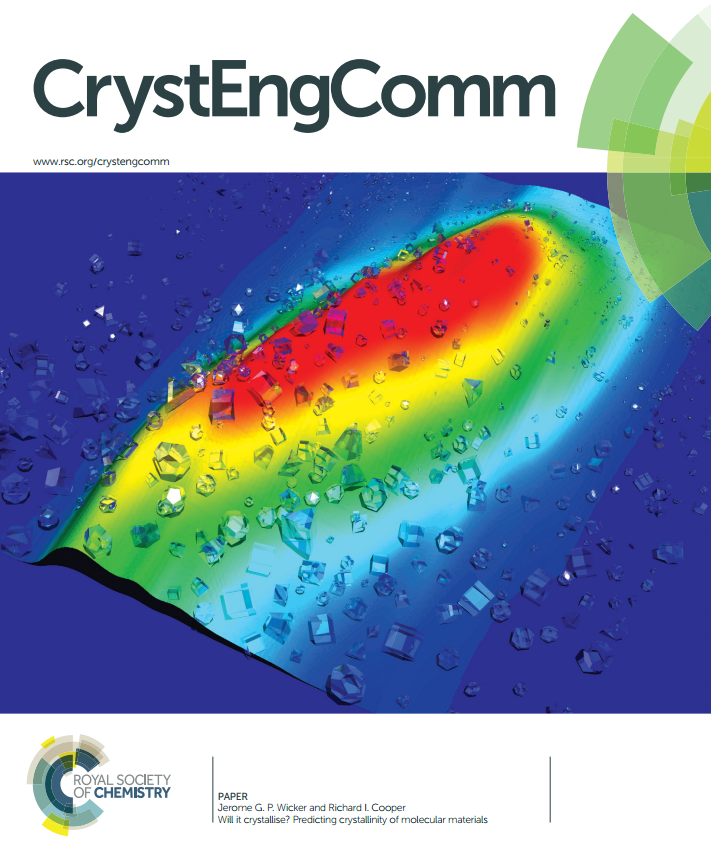
Solid State Photochemistry
Deadline: 1st April 2016
Guest Editors: Dr Jacqui Cole (University of Cambridge), Professor Masahiro Irie (Rikkyo University)
The issue will focus on photochemical reactions and photophysical structure and properties of solid-state materials, ranging from the crystalline state to interfacial structures that involve at least one solid phase.
Studies on photochemical reactions will include photochromic reactions, the photomechanical effect, light induced phase transitions, light-induced morphological changes, molecular machines and photoswitches, and spin crossover materials. Such studies can be applied to any crystalline material, including single crystals, microcrystalline powders and nanocrystals.
Studies on photophysical structure and properties of materials will focus on optoelectronic media, photovoltaic applications, non-linear optical effects, and other optical phenomena. Papers may concern bulk media or interfacial structures that include at least one solid phase. Results will describe relationships between chemical structure and photophysical function or feature some physical chemistry aspect of a solid-state photo-induced phenomenon. We are equally happy to consider experimental and/or computational studies within this arena.
Crystal engineering of composite materials
Guest Editor: Professor Kwangyeol Lee (Korea University).
Deadline: 12th April 2016
This themed issue will focus on crystal engineering of composite materials, particularly in the areas of energy conversion and energy storage, providing insights into the growth behaviour of these complex systems.
The issue will address different aspects of crystal design in/for hybrid materials, such as changes in crystal growth behaviour – namely, changes in morphology or phase, on different supports or by additional components in the system.
Do you work in the field of composite materials? If so, let us know using the link below.
How to submit
All types of manuscript – communications, full papers and Highlights, will be considered for publication. The manuscript should be prepared according to our article guidelines and submitted via our online system.
All manuscripts will be subject to normal peer review and inclusion in the themed issue will be at the discretion of the Guest Editors. Please indicate in your submission the name of the themed issue that you would like to be considered for.
Are you interested in contributing? Contact us for further details

















